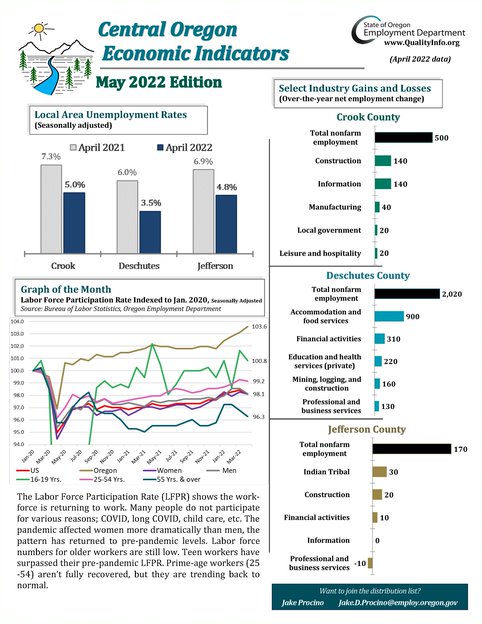Economy in Central Oregon
Deschutes’ and Jefferson’s employment grew by 2.3% (2,020 jobs) and 2.6% (170), respectively, over the last 12 months, which was slightly slower than the Oregon average of 4.1%. Crook had a healthy growth rate of 7.4%, adding 500 jobs. Crook and Jefferson have returned to pre-pandemic employment levels, while Deschutes sits about 1,000 jobs short.
The seasonally-adjusted unemployment rate in Oregon edged down to 3.7% in April, reaching its lowest level in two years, nearly reaching Oregon’s record low of 3.4% which happened in November 2019 through February 2020. Unemployment also dropped over the past year in all three Central Oregon counties to near record lows. Crook sits at 5.0% (lowest monthly ever is 4.7%), Deschutes sits at 3.5% (3.3%), and Jefferson sits at 4.8% (4.4%).
Topic of the Month: Labor Force Participation Rate (LFPR)
The Labor Force Participation Rate (LFPR) indexed to Jan. 2020 measures how LFPR has changed since pre-pandemic. The index suggests the workforce is largely returning to work, especially in Oregon. However, many people do not participate for various reasons: COVID, long COVID, child care, etc.
While the pandemic affected women’s LFPR more significantly than men’s, the distance between the two has returned to the pre-pandemic difference (women’s regular LFPR lags behind men by about 12 percentage points).
Older workers are not returning to the labor force as strongly as their younger counterparts, though this is mostly due to the large proportion of “on-schedule” retirements (those ages 65+ leaving the workforce). Teen workers (16-19) have surpassed their pre-pandemic LFPR. This increase in LFPR might partially explain the continued decline in college enrollment. And finally, while prime-age workers (25-54) aren’t quite fully back in the labor force, they are steadily trending back to normal.

You can explore LFPR for yourself through the St. Louis Fed here.






0 Comments